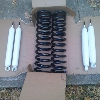edge929
Well-Known Member
- Joined
- October 22, 2010
- Messages
- 323
- Reaction score
- 1
- City, State
- Des Moines, IA
- Year, Model & Trim Level
- 2011 Ford Explorer XLT
So the owner's manual states to vary the RPMs for the first 1000 miles. This is pretty standard for nearly ALL new vehicles (and motorcycles). Varying the RPMs is achieved easily with in-town driving but 1000 miles is a lot for me to rack up in town seeing how I live 4 miles from work. I was looking to plan a 1.5 hour (one way) road trip soon and this will be all highway/interstate.
So my question is, just how important is this 1000 mile break-in/varying the RPMs? I plan on keeping my Explorer for 10+ years so I want to do it right, no matter how inconvenient it is now.
I remember having to do this with all 3 new motorcycles I've bought in the past. Driving them home was a pain as I would slow down on the interstate/highway to 45 for a couple minutes, then speed up to 55, 65, 75 and repeat. Never had a problem with any of them and I racked up 40K miles on one (all crotch rockets).
If anyone with more knowledge than myself cares to explain the engineering behind this I would love to know (ie for gaskets to seal correctly? work out any remaining machined metal floating in the oil?, etc).
So my question is, just how important is this 1000 mile break-in/varying the RPMs? I plan on keeping my Explorer for 10+ years so I want to do it right, no matter how inconvenient it is now.
I remember having to do this with all 3 new motorcycles I've bought in the past. Driving them home was a pain as I would slow down on the interstate/highway to 45 for a couple minutes, then speed up to 55, 65, 75 and repeat. Never had a problem with any of them and I racked up 40K miles on one (all crotch rockets).
If anyone with more knowledge than myself cares to explain the engineering behind this I would love to know (ie for gaskets to seal correctly? work out any remaining machined metal floating in the oil?, etc).










